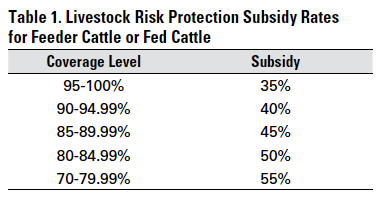Equip Your Company: Bagley Risk Management Insights
Equip Your Company: Bagley Risk Management Insights
Blog Article
Comprehending Animals Risk Defense (LRP) Insurance Coverage: A Comprehensive Overview
Navigating the realm of animals danger security (LRP) insurance can be a complex undertaking for several in the agricultural field. From just how LRP insurance operates to the different protection options available, there is much to discover in this extensive guide that can potentially form the means animals manufacturers approach threat monitoring in their organizations.

How LRP Insurance Coverage Functions
Periodically, recognizing the mechanics of Animals Danger Protection (LRP) insurance can be complicated, however breaking down exactly how it works can offer quality for breeders and farmers. LRP insurance is a risk administration tool created to protect livestock manufacturers against unforeseen cost declines. It's important to note that LRP insurance is not an income guarantee; rather, it concentrates entirely on rate risk protection.
Qualification and Protection Options

When it comes to protection alternatives, LRP insurance coverage provides manufacturers the adaptability to select the insurance coverage level, insurance coverage duration, and recommendations that finest suit their risk administration needs. Coverage degrees normally vary from 70% to 100% of the anticipated ending value of the insured animals. Manufacturers can additionally select insurance coverage periods that straighten with their manufacturing cycle, whether they are guaranteeing feeder livestock, fed cattle, swine, or lamb. Endorsements such as price risk defense can further customize protection to shield against unfavorable market variations. By understanding the eligibility requirements and coverage choices offered, livestock producers can make educated decisions to take care of risk successfully.
Advantages And Disadvantages of LRP Insurance
When assessing Animals Threat Protection (LRP) insurance, it is essential for livestock producers to weigh the downsides and benefits inherent in this danger management tool.

One of the primary benefits of LRP insurance coverage is its capability to give security versus a decline in animals costs. Additionally, LRP insurance policy uses a level of flexibility, enabling producers to personalize insurance coverage degrees and policy durations to match their particular needs.
However, there are likewise some downsides to think about. One find out constraint of LRP insurance policy is that it does not protect against all types of dangers, such as disease outbreaks go to this site or all-natural disasters. Premiums can in some cases be expensive, particularly for producers with large livestock herds. It is crucial for manufacturers to meticulously examine their specific threat exposure and monetary circumstance to determine if LRP insurance policy is the appropriate risk monitoring tool for their operation.
Understanding LRP Insurance Premiums

Tips for Taking Full Advantage Of LRP Perks
Optimizing the advantages of Animals Danger Security (LRP) insurance coverage requires calculated planning and proactive danger administration - Bagley Risk Management. To maximize your LRP insurance coverage, think about the following pointers:
Routinely Analyze Market Problems: Remain educated concerning market patterns and cost fluctuations in the animals industry. By checking these factors, you can make informed decisions regarding when to acquire LRP insurance coverage to shield against possible losses.
Set Realistic Coverage Levels: When choosing coverage degrees, consider your production costs, market value of animals, and potential dangers - Bagley Risk Management. Setting sensible coverage levels guarantees that you are effectively safeguarded without overpaying for unnecessary insurance coverage
Expand Your Insurance Coverage: As opposed to relying only on LRP insurance, consider diversifying your danger administration approaches. Integrating LRP with various other risk monitoring devices such as futures contracts or options can give thorough coverage against market uncertainties.
Review and Change Coverage Frequently: As market conditions change, periodically evaluate your LRP protection to ensure it lines up with your current danger exposure. Changing coverage levels and timing of acquisitions can aid enhance your threat protection technique. By adhering to these tips, you can maximize the benefits of LRP insurance and secure your livestock operation against unexpected risks.
Final Thought
Finally, livestock More hints danger defense (LRP) insurance is a beneficial tool for farmers to handle the economic threats connected with their livestock procedures. By recognizing how LRP works, eligibility and coverage choices, as well as the advantages and disadvantages of this insurance, farmers can make informed decisions to secure their livelihoods. By meticulously considering LRP premiums and executing approaches to optimize benefits, farmers can reduce prospective losses and ensure the sustainability of their operations.
Animals manufacturers interested in getting Livestock Danger Defense (LRP) insurance policy can explore an array of qualification criteria and coverage options customized to their specific animals operations.When it comes to coverage options, LRP insurance offers manufacturers the flexibility to select the protection degree, coverage duration, and endorsements that finest fit their danger administration demands.To realize the intricacies of Animals Threat Defense (LRP) insurance coverage fully, recognizing the aspects influencing LRP insurance coverage premiums is crucial. LRP insurance premiums are determined by different components, consisting of the protection level picked, the expected cost of animals at the end of the insurance coverage duration, the type of livestock being insured, and the size of the protection duration.Review and Change Coverage Regularly: As market problems alter, periodically review your LRP protection to ensure it aligns with your present risk direct exposure.
Report this page